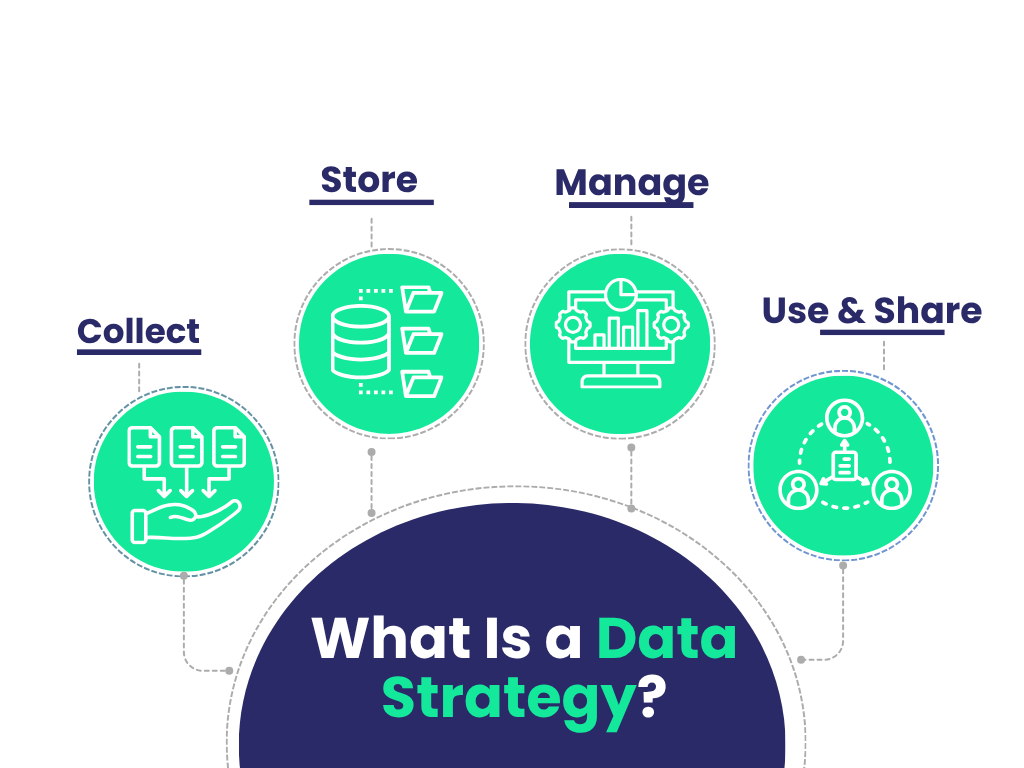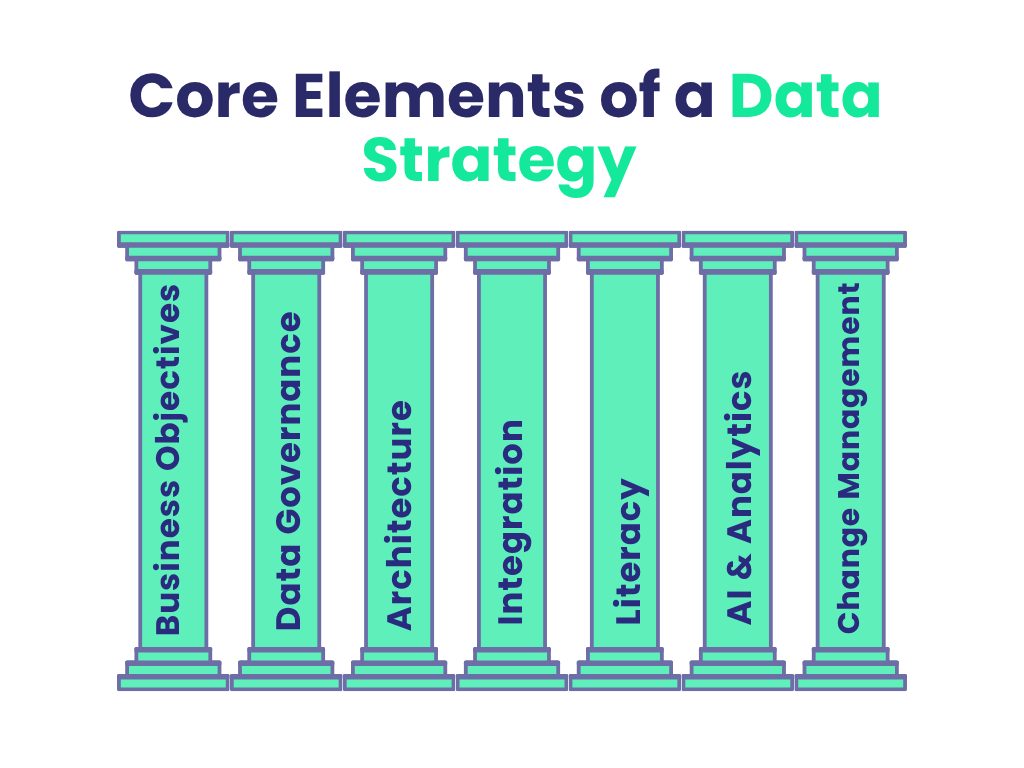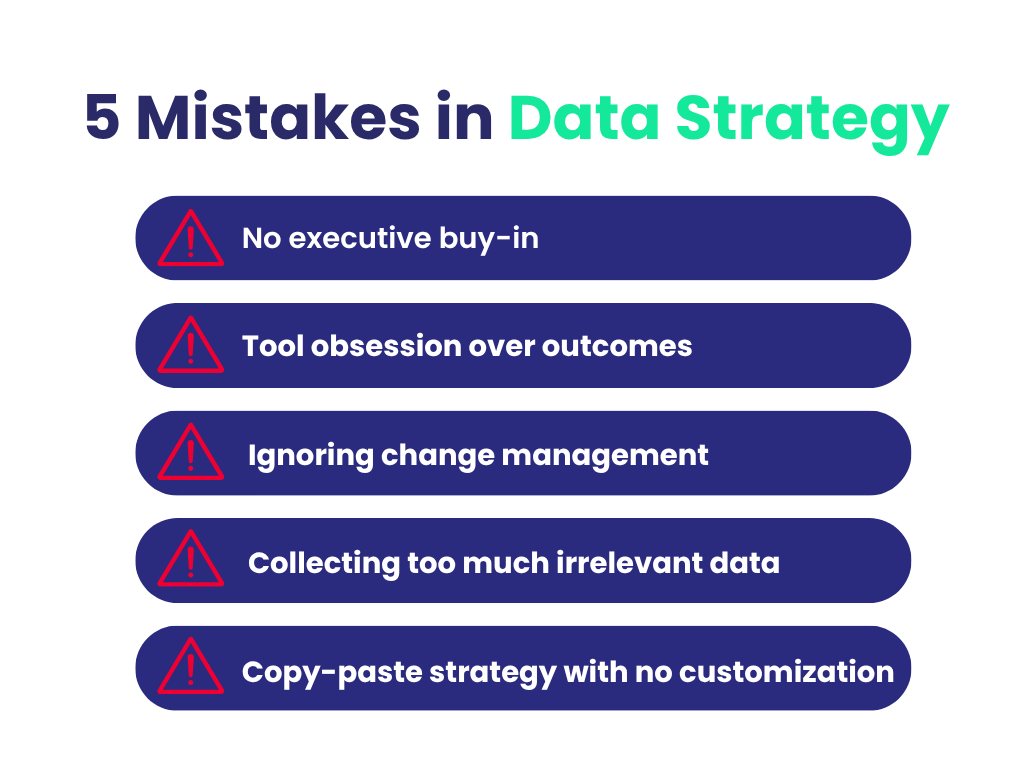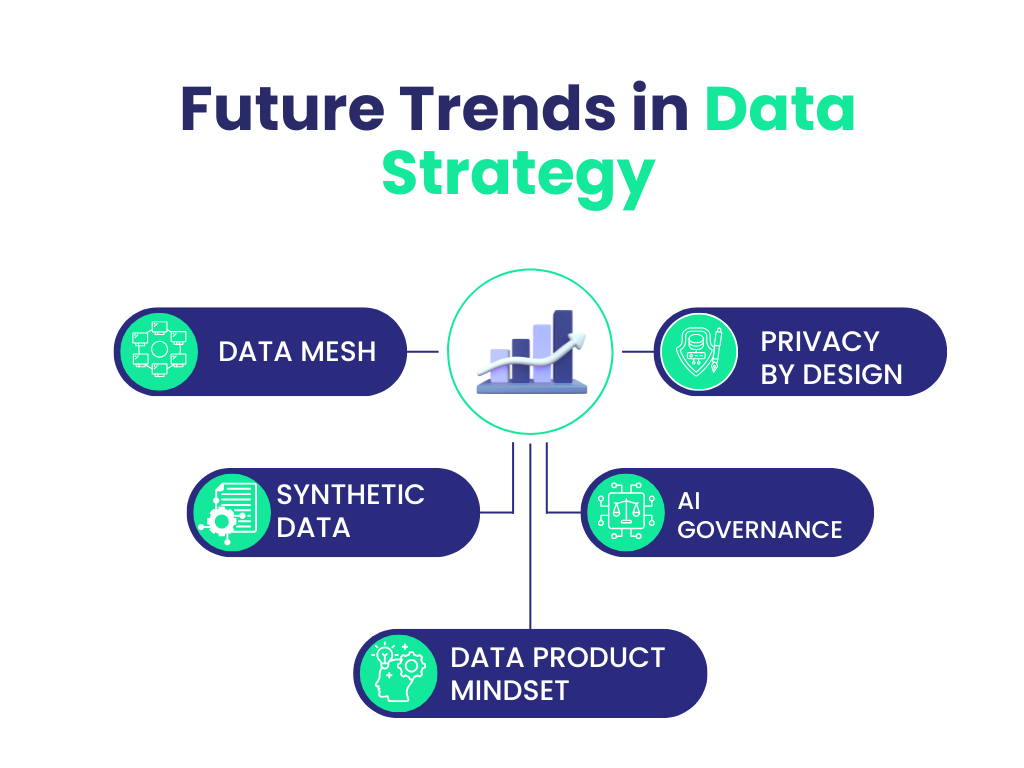In today’s hyper-competitive landscape, data is more than just numbers – it’s the foundation of every successful decision, innovation, and customer experience. But without a data strategy, even the richest data pools can become ineffective. Whether you’re running a startup or a global enterprise, developing a strong, actionable data strategy is no longer optional – it’s essential.
In this blog, we’ll walk you through what a successful data strategy looks like, how to build one, and why it’s the key to a future-ready business.
What Is a Data Strategy?
A data strategy is a structured plan that outlines how a business collects, stores, manages, shares, and uses data. It ensures that data is aligned with business goals and drives value across departments.
Think of it as a data roadmap. It connects your technology, people, processes, and policies to make data a strategic asset rather than a byproduct.
It is the compass that prevents businesses from drifting in data chaos. A strong strategy enables companies to answer fundamental questions: What data do we need? Who should access it? How do we protect it? And how do we turn it into insight?
To illustrate its significance, imagine data as fuel and strategy as the engine. One without the other results in inefficiency or failure. A well-oiled engine can take raw fuel and power a vehicle to reach a clear destination – your business goals.
Why Every Business Needs a Data Strategy
The benefits of a data strategy go far beyond IT. A well-executed data strategy plan can:
- Improve decision-making through reliable insights
- Streamline operations with better data governance
- Enable personalized customer experiences
- Drive innovation using advanced analytics and AI
- Reduce compliance risks
- Empower agile responses to market changes
Companies without a data-driven strategy often suffer from fragmented insights, duplicated efforts, and reactive decision-making. On the other hand, businesses with mature data strategies are more adaptable, competitive, and aligned with their customers’ needs.
Case in point: Netflix leverages a robust data strategy to recommend content, optimize streaming performance, and even greenlight new productions based on viewer preferences – all driven by data.
Data Strategy vs. Data Analytics Strategy
It’s important to distinguish between a data strategy and a data analytics strategy:
- A data strategy focuses on the management, governance, quality, and accessibility of data.
- A data analytics strategy focuses on how data is interpreted, analyzed, and turned into business insights.
Think of data strategy as the foundation and data analytics as the superstructure. One ensures you have clean, available data; the other ensures you’re using it meaningfully.
You need both to truly become a data-driven organization. One builds the foundation; the other builds the insights.
Key Elements of a Successful Data Strategy
Building a successful data strategy involves several core components. Each plays a vital role in turning raw data into actionable intelligence.
1. Clear Business Objectives
Your data strategy plan must align with your organization’s short-term and long-term goals. Whether it’s improving customer retention, entering a new market, or reducing operational costs, your data efforts should directly support these objectives.
Avoid generic ambitions. Instead, tie your data initiatives to specific KPIs – like increasing Net Promoter Score (NPS), reducing customer churn by 15%, or increasing supply chain transparency by 40%.
2. Data Governance
Define how data will be managed across your organization. This includes:
- Roles and responsibilities
- Data quality standards
- Security and compliance protocols
- Metadata management
Effective governance fosters trust and transparency. It’s about ensuring that data is consistent, reliable, and used ethically – especially in industries like healthcare, finance, and education.
A real-life example comes from the healthcare sector. Hospitals with strong governance frameworks report fewer patient data errors and faster diagnostics because their data is centralized, accurate, and secure.
3. Data Architecture
Set up the right systems and technologies to handle your data needs. This includes databases, cloud storage, ETL tools, data lakes, and real-time pipelines. A strong architecture is the backbone of a scalable data strategy.
Consider future-proofing here. Will your architecture support AI workloads in two years? Will it handle IoT data? Scalability and flexibility should be key design principles.
4. Data Integration
Ensure all your systems communicate with each other. Integrating data from multiple sources – CRM, ERP, marketing platforms, IoT – allows for a unified, 360-degree view of your business.
Without integration, insights remain trapped in silos. Modern data strategies use APIs, middleware, and ELT/ETL pipelines to break those silos down.
A supply chain company that integrates vendor, logistics, and customer data into one dashboard can react to delivery disruptions in real time, enhancing customer satisfaction and operational efficiency.
5. Data Literacy
Technology is useless without people. Invest in data literacy so teams can understand and use data effectively. This builds a data-driven culture where employees at all levels trust and rely on data.
From frontline staff to executives, democratizing data understanding leads to smarter decisions and fewer bottlenecks.
Global companies like Mastercard have created internal academies to boost data literacy, ensuring even non-technical teams can extract value from insights.
6. Analytics and AI Capabilities
Once data is structured and accessible, layer it with analytics tools, dashboards, machine learning models, and predictive engines. This is where data strategies start driving innovation.
Use AI for fraud detection, forecasting, sentiment analysis, and process automation. Let data not only describe what happened but also predict what’s coming.
7. Change Management
A data-driven strategy requires organizational change. Be ready to overcome resistance and promote cross-department collaboration. Success hinges on adoption.
This involves training, executive buy-in, and embedding new workflows across departments. Highlight success stories to build momentum.
One effective technique is the “champion model,” where key stakeholders in each department are trained first and then serve as advocates and support pillars during rollout.
Developing a Data Strategy: Step-by-Step
If you’re wondering how to create a data strategy from scratch, here’s a simplified step-by-step guide:
Step 1: Define Your Vision
Ask: What does success look like for us? Your vision should reflect how data will enable strategic outcomes, not just technical goals. Example: “Use real-time customer data to boost personalization by 40% within 12 months.”
Step 2: Audit Existing Data
What data do you currently collect? Where does it live? Is it accurate? Perform a data inventory and assess data quality to identify gaps.
Look for shadow data – data that’s collected unofficially and might pose risks. Clean up and consolidate.
Step 3: Identify Use Cases
Pinpoint 3 to 5 high-impact use cases – like churn prediction, sales forecasting, or campaign optimization. These data strategy examples will guide your investments and showcase early wins.
Use cases create buy-in, reduce resistance, and prove ROI.
Step 4: Build the Right Infrastructure
Choose tools and platforms that align with your scale and speed needs – cloud vs. on-premise, real-time vs. batch processing, SQL vs. NoSQL, etc.
Also evaluate data security, latency tolerance, and compliance alignment.
Step 5: Create Governance Frameworks
Establish roles, permissions, data ownership policies, and compliance checklists (especially for GDPR, HIPAA, or industry-specific standards).
Make governance everyone’s responsibility, not just IT’s.
Step 6: Develop a Talent Roadmap
Do you need data engineers, analysts, scientists, or governance leads? A successful strategy balances internal teams with external partners.
Plan for upskilling and cross-functional collaboration.
Step 7: Monitor, Iterate, and Scale
A data strategy isn’t set and forget. Set up KPIs and regularly evaluate what’s working. Adjust as your business evolves.
Use a data maturity model to assess progress and identify next steps.
Data Strategy Example: From Chaos to Clarity
Let’s look at a real-world data strategy example.
Company: A mid-size retail chain
Challenge: Siloed customer data, inconsistent reporting, poor forecasting
Solution:
- Conducted a data audit and found 15+ disconnected sources
- Implemented a modern data warehouse
- Integrated CRM, POS, and e-commerce data
- Created a governance committee and trained staff on data tools
- Used predictive analytics for inventory management
Results:
- 30% improvement in sales forecast accuracy
- 25% faster marketing campaign rollouts
- 3x growth in customer retention insights
This illustrates how building a data strategy can transform operations and boost performance.
Common Pitfalls to Avoid in Your Data Strategy
Even the best plans can fail if you fall into these traps:
- No executive sponsorship: Without C-suite buy-in, progress stalls.
- Too tech-focused: Don’t prioritize tools over outcomes.
- Lack of change management: Culture change is just as important as system change.
- Data hoarding: More data doesn’t mean better decisions. Focus on relevance, not volume.
- One-size-fits-all approach: Customize strategy to industry needs and business size.
The Future of Data-Driven Strategy
As technologies like AI, IoT, and real-time analytics evolve, your data strategy must be flexible. Expect trends like:
- Data Mesh: Decentralized data ownership by domain
- Privacy by Design: Embedding compliance from the ground up
- Automated Data Ops: Using AI to manage pipelines and detect anomalies
- AI Governance: Ensuring transparency in ML-driven decisions
- Synthetic Data: For privacy-safe, accelerated model training
Another rising trend is the data product mindset – treating data like a product with defined ownership, quality standards, and version control. This improves consistency and accelerates time to value.
Final Thoughts: Make Data Your Competitive Edge
To build a successful data strategy, you don’t need to be a tech giant. You just need alignment, vision, and the right execution framework.
Your data strategy should reflect your business DNA – where you are today and where you want to go tomorrow. When done right, it becomes the engine that powers innovation, efficiency, and growth.
So whether you’re developing a data strategy for the first time or refining your existing one, remember: the value isn’t just in the data. It’s in the strategy and data working hand in hand.
Frequently Asked Questions (FAQs)
Q1: What is the difference between a data strategy and a data strategy plan?
A data strategy is the overall approach, while a data strategy plan includes the detailed steps and roadmap for implementation.
Q2: What is a data strategy example for small businesses?
A small retail store integrating sales and customer data to personalize offers and forecast inventory demand is a classic data strategy example.
Q3: How long does it take to build a data strategy?
It depends on your data maturity, but most companies see meaningful progress in 3 to 6 months if the right teams are involved.
Q4: Why is data governance important in a data-driven strategy?
Without governance, data can be misused, duplicated, or non-compliant, leading to risks and inefficiencies.
Q5: How often should a data strategy be reviewed?
Ideally, review your data strategy quarterly, with a comprehensive annual update based on evolving business priorities and technology shifts.










